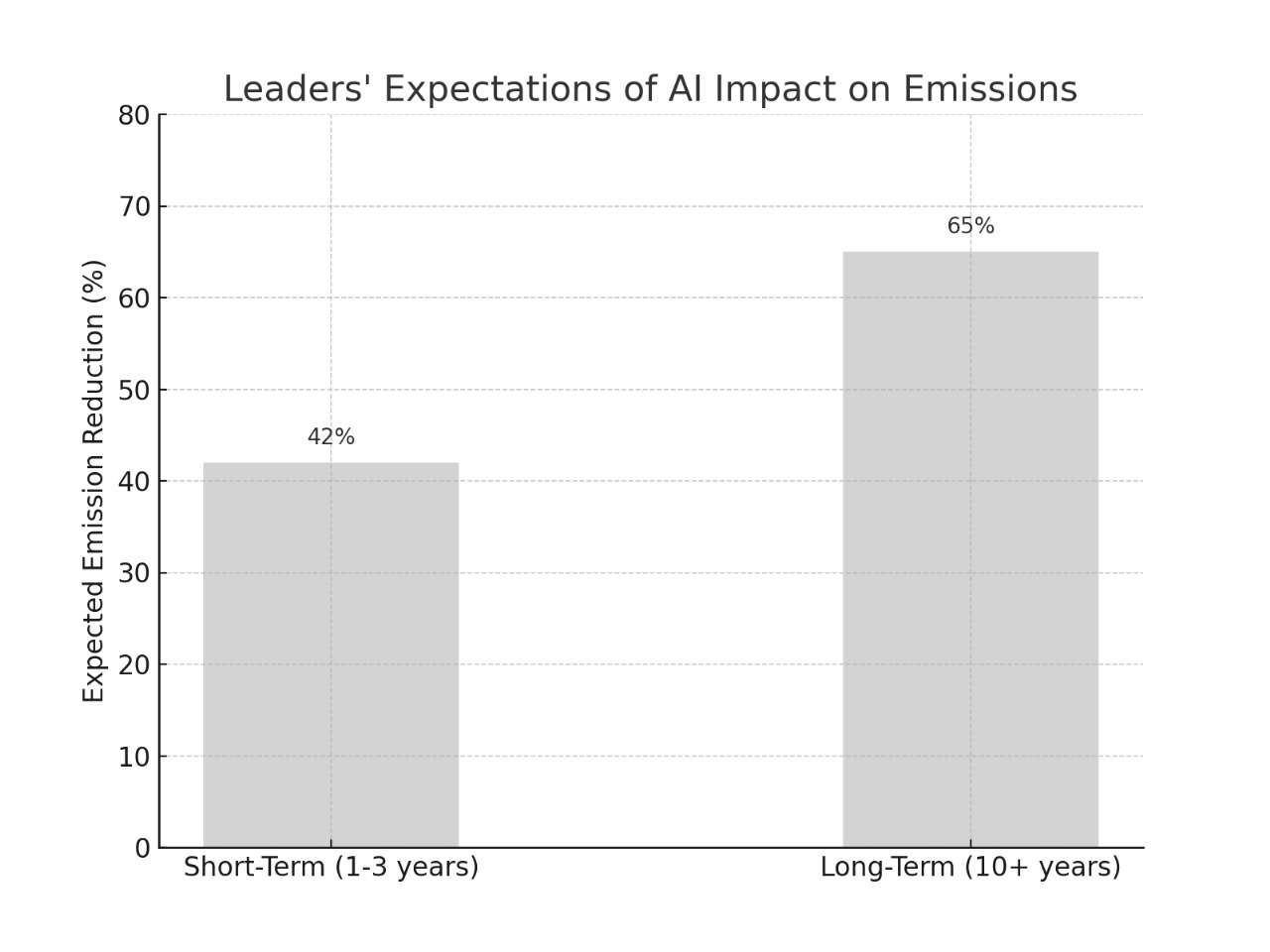
The Current Landscape: Progress and Challenges
A 2024 Accenture analysis of the world’s 2,000 largest companies found that only 16% are on track to achieve net-zero emissions by 2050. Alarmingly, nearly 45% have reported increased emissions.
The majority of leaders have high hopes for AI’s role in decarbonization. When asked how they anticipate AI’s impact on global emissions, leaders are more likely to predict that it would lower emissions (42%) than increase them (27%), and a resounding majority (65%) anticipate that AI will lower emissions over the long run (10+ years).

Financial Imperatives
Report from consultancy Wood Mackenzie, achieving global net-zero emissions by 2050 requires an estimated annual investment of $2.7 trillion, primarily in power and infrastructure sectors. India’s transition alone presents a $12.7 trillion investment opportunity, emphasizing the scale and potential of this endeavour.
Technological Emissions Risks
Artificial Intelligence (AI) and Data Centers
While AI offers tools for emissions reduction, its deployment is energy intensive. Accenture projects that AI-related emissions could rise more than tenfold by 2030 without significant innovation in energy systems and computing technologies.
Data centers consume vast amounts of electricity to power servers and maintain cooling systems. In fact, data centers alone are responsible for approximately 1-2% of global electricity use, and this figure is expected to rise sharply as AI adoption expands.
Moreover, the training of a single large AI model can emit as much carbon, depending on the energy source powering the data center.
High Costs of Climate Technologies
A Capgemini report highlights that 65% of organizations recognize the necessity of climate technologies to achieve net-zero goals. However, 77% cite high costs as a barrier to widespread adoption, underscoring the need for affordable solutions.
Why Are Climate Technologies So Expensive?
High Upfront Capital Investment
Climate technologies like solar farms and CCS systems require millions in initial setup costs. These investments are high before any long-term savings can be realized.
Limited Economies of Scale
Many technologies are in early stages and not yet mass-produced. Low production volumes keep prices high.
Complex Installation and Maintenance
Specialized components and skilled labor drive up costs. Rural and developing regions face even higher setup challenges.
Regulatory and Certification Costs
Meeting compliance, safety, and certification standards adds cost and delays. This burden is heavier for global and cross-border projects.
R&D and Innovation Expenses
Technologies like DAC and next-gen batteries are costly to develop. Companies pass on these R&D costs to early adopters.
Lack of Subsidies or Incentives
Fossil fuels often receive more support than green tech. Without subsidies or carbon pricing, climate tech remains less competitive.
Infrastructure Limitations
India’s Economic Survey 2024-25 emphasizes the critical need for extensive grid infrastructure to support the country’s net-zero ambitions by 2070.
Without significant upgrades, integrating renewable energy sources and ensuring energy security remain challenging. Renewable energy push faces major hurdles due to limited transmission capacity, as clean power sources are often far from demand centers.
Challenges and Risks
Adopting net-zero carbon emissions is a vital step in combating climate change, but it comes with significant challenges and risks that governments, businesses, and societies must address effectively.
High Financial Costs
- Transitioning to low-carbon technologies often requires substantial upfront investments in renewable energy, infrastructure, carbon capture, and electrification.
- Developing countries, in particular, face difficulty securing climate finance, limiting their ability to invest at scale.
Technological Limitations
- Many decarbonization technologies (like green hydrogen, long-duration storage, and carbon capture) are still in the early stages of development or are too costly for widespread deployment.
- In hard-to-abate sectors such as cement, steel, and aviation, low-carbon alternatives are not yet commercially viable at scale.
Policy and Regulatory Gaps
- Inconsistent or unclear regulations and carbon pricing mechanisms across regions create uncertainty for investors and businesses.
- Lack of cohesive global coordination also enables carbon leakage, where emissions intensive industries relocate to countries with lax standards.
Energy Security Risks
- A rapid shift away from fossil fuels without adequate backup can cause grid instability, energy shortages, or price volatility especially in regions still reliant on coal and oil.
- Over-dependence on certain minerals (like lithium, cobalt) for renewables and batteries could also create geopolitical supply chain vulnerabilities.
Social and Economic Disruption
- Industries tied to fossil fuels face job losses and economic decline, particularly in regions lacking transition plans or social safety nets.
- Without just transition frameworks, the shift to net zero can exacerbate inequality, triggering public resistance or social unrest.
Measurement and Accountability Challenges
- Tracking emissions reductions and setting credible net-zero targets is complex, especially with scope 3 emissions (indirect emissions from supply chains).
- There’s also a risk of greenwashing companies overstating their climate efforts to appear sustainable without meaningful change.
Time Sensitivity
- Achieving net-zero by mid century requires immediate and sustained action. Delays today will amplify future costs and risks, including irreversible climate impacts.
Solutions
Scaling Renewable Energy and Infrastructure
Investing in renewable energy sources like wind and solar is paramount. Wood Mackenzie reports that renewables account for approximately 43% of India’s total power generation capacity, including hydroelectric power.. India’s addition of 53 gigawatts of solar and wind energy between 2018 and 2022 exemplifies progress in this area.
Advancing Low-Carbon Technologies
The adoption of low-carbon hydrogen, carbon capture, and alternative fuels is crucial. These technologies can significantly reduce emissions, especially in hard-to-abate sectors like steel and cement production.
Policy and Incentives
Government incentives play a vital role in accelerating the transition. PWC survey highlights that 50% of Indian businesses surveyed have made net-zero commitments, with 48% aiming to achieve these goals by 2030, indicating an accelerated approach to decarbonization.
Public Engagement and Behavioral Change
India’s Lifestyle for Environment (LiFE) initiative aims to promote sustainable practices among citizens. By encouraging mindful consumption and production, such programs can contribute significantly to emissions reduction.
References
- Only 16% of Largest Companies on Track for Net Zero Goals with Nearly Half Seeing Increased Emissions, Accenture Analysis Finds
- World needs $2.7 trillion annually for net zero emissions by 2050: Wood Mackenzie – Times of India
- Three quarters of organizations say they need climate tech to achieve net zero goals but lower costs are essential for widespread adoption – Capgemini
- Economic Survey 2024-25
- Chance of a lifetime: Can India show the developing world a unique path to net zero? | Wood Mackenzie
- Faster Deployment of Clean Power Such as Solar, Wind and EVs Can Enable India to Peak Emissions Before 2030 | BloombergNEF
- ~50% of Indian businesses plan to prioritise tax transparency in ESG practices: PwC India survey
- Lifestyle for Environment – LiFE | MyGov.in


